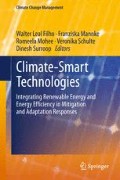Abstract
Mauritius is highly dependent on fossil fuel imports for its own energy provision with only a minor contribution of renewable energy sources. Mauritius has however got potentials to increase its renewable energy share through increased biomass use. Conversely, there are several problems associated with biomass which reduces its appeal as a fuel compared to conventional fossil fuels. Pre-treatment technologies can nevertheless help valorise biomass. Torrefaction is known to be a mild pyrolysis process during which the lignocellulosic material in the biomass is decomposed and moisture and volatiles are eliminated. In this paper, the effect of torrefaction on the energy content and the chemical composition of four different locally available biomass feedstocks in Mauritius namely: Elephant grass (Napier grass), cane tops and leaves, wood wastes and palm trunks have been investigated. Samples of the biomass were treated at varying temperatures in the range of 200–300 °C in an inert atmosphere with a residence time of 1–3 h. The optimum residence time and temperature for each of the different biomass feedstock were determined. Enhancement ratios in the energy content of the torrefied biomass varied from 1.01 to 1.42. It was found that 1 kg of torrefied biomass could displace 0.776–0.855 kg of coal and reduce emissions of greenhouse gases from 2.01 to 2.34 kg. It was evaluated that savings of Rs. 3.19, Rs. 3.34, Rs. 3.52 and Rs. 3.29 per kg of torrefied sawdust, elephant grass, and CTL and palm wastes could also be made.
Access this chapter
Tax calculation will be finalised at checkout
Purchases are for personal use only
References
Almeida G, Brito JO, Perre P (2010) Alterations in energy properties of eucalyptus wood and bark subjected to torrefaction: The potential of mass loss as a synthetic indicator. Bioresour Technol 101:9778–9784
Arias B, Pevida C, Fermoso J, Plaza MJ, Rubier F, Pisa JJ (2008) Influence of torrefaction on the grindability and reactivity of woody biomass. Fuel Process Technol 89(2):169–175
Baxter LL, Miles TR, Jerkins BM, Milne T, Dayton D, Bryers RW (1998) The expected behaviour of inorganic material in biomass-fired power boilers: field and laboratory experiences. Fuel Process Technol 54:47–48
Bergman PCA (2005) Combined torrefaction and pelletisation: the top process Available at: http://www.ecn.nl/docs/library/report/2005/c05073.pdf
Bergman PCA, Boersma AR, Zwart RWR, Kiel JHA (2005) Torrefaction for biomass co-firing in existing coal-fired power stations. Available at: http://kernenergie.nl/pub/www/library/report/2005/c05013.pdf
Bridgeman TG, Jones JM, Shield I, Williams PT (2008) Torrefaction of reed canary grass, wheat straw and willow to enhance solid fuel qualities and combustion properties. Fuel 87:844–846
Chang K, Lin W, Ross G, Chung K (2011) Dissemination of solar water heaters in South Africa. J Energy S Afr 22(3):1–15
Chen W And, Kuo P (2011) Torrefaction and co-torrefaction characterization of hemicellulose, cellulose and lignin as well as torrefaction of some basic constituents in biomass. Energy 36:80–811
Chen W, Cheng W, Lu K, Huang Y (2011) An evaluation on improvement of pulverised biomass property for solid fuel through torrefaction. Appl Energy 88(11):3636–3644
Chew JJ, Doshi V (2011) Recent advances in biomass pretreatment: torrefaction fundamentals and technology. Renew Sustain Energy Rev 15:4212–4222
CSO (2010) Digest of energy and water statistics-2010, Available at: http://www.gov.mu/portal/goc/cso/report/natacc/energy10/energy.pdf
Kahn C (2012) Oil price stays around $103 per barrel, Available at: http://www.businessweek.com/ap/financialnews/D9S2BC880.htm
Kongkeaw N, Patumsawad S (2011) Thermal upgrading of biomass as a fuel by Torrefaction. IPCBEE 17
Kumar P, Barett DM, Delwiche MJ, Stroeve P (2009) Methods for pretreatment of lignocellulosic biomass for efficient hydrolysis and biofuel production. Ind Eng Chem Res 48:3713–3723
Li H, Hui X, Legros R, Bi XT, Lim CJ, Sokhansaj SJ (2012) Torrefaction of sawdust in s fluidised bed reactor. Bioresour Technol 103(1):453–458
Mauritius Meteorological Services (2012) Climate change. Available (Mar 2012) http://metservice.intnet.mu/?cat=46
Medic M, Darr M, Shah A, Potter B, Zimmerman J (2012) Effects of torrefaction process parameters on biomass feedstock upgrading. Fuel 91:147–154
Patel B, Gami B, Bhimani H (2011) Improved fuel characteristics of cotton stalk, prosopis and sugarcane bagasse through torrefaction. Energy Sustain Dev 15(4):4–7
Pierre F, Almeida G, Brito JO, Perre P (2011) Influence of torrefaction on some chemical and energy properties of maritime pine and pedunculate oak. BioResources 6(2):1204–1218
Ponder GR, Richards GN (1991) Carbohydrate. Research 218:143–155
Riley D (2000) The coming energy crisis. Infinite energy [online], 6(34). Available at: http://www.infinite-energy.com/iemagazine/issue34/comingenergycrisis.html
Rousset P, Aguiar C, Labbe N, Commandre J (2011) Enhancing the combustible properties of bamboo by torrefaction. Bioresour Technol 102(17):8225–8231
Shen DK, Gu S, Bridgwater AV (2010) Study on the pyrolytic behaviour of xylan-based hemicellulose using TG–FTIR and Py–GC–FTIR. J Anal Appl Pyrolysis 87:199–206
Uemura W, Omarch W, Tsutsui T, Subbarao D, Yusup S (2010) Relationship between calorific value and elementary composition of torrefied lignocellulosic biomass. J Appl Sci 10:3250–3256
UNFCCC (2007) Climate change: impacts, adaptability and vulnerability in developing countries. Available at: http://unfccc.int/resource/docs/publications/impacts.pdf
US DOE (2011) What is bioenergy and how and where can I use it? Available at: http://www1.eere.energy.gov/biomass/biomass_basics_faqs.html
Yan W, Acharjee TC, Coronella CJ, Vasquez VR (2009) Thermal pretreatment of lignocellulosic biomass. Environ Prog Sustain Energy 28:435–440
Zhang L, Chunbao X, Champagne P (2010) Overview of recent advances in thermo-chemical conversion of biomass. Energy Convers Manage 51:969–982
Author information
Authors and Affiliations
Corresponding author
Editor information
Editors and Affiliations
Rights and permissions
Copyright information
© 2013 Springer-Verlag Berlin Heidelberg
About this paper
Cite this paper
Dinesh, S., Devina, M. (2013). Assessing the Potential of Torrefaction for Locally Available Biomass in Mauritius. In: Leal Filho, W., Mannke, F., Mohee, R., Schulte, V., Surroop, D. (eds) Climate-Smart Technologies. Climate Change Management. Springer, Berlin, Heidelberg. https://doi.org/10.1007/978-3-642-37753-2_40
Download citation
DOI: https://doi.org/10.1007/978-3-642-37753-2_40
Published:
Publisher Name: Springer, Berlin, Heidelberg
Print ISBN: 978-3-642-37752-5
Online ISBN: 978-3-642-37753-2
eBook Packages: Business and EconomicsEconomics and Finance (R0)

